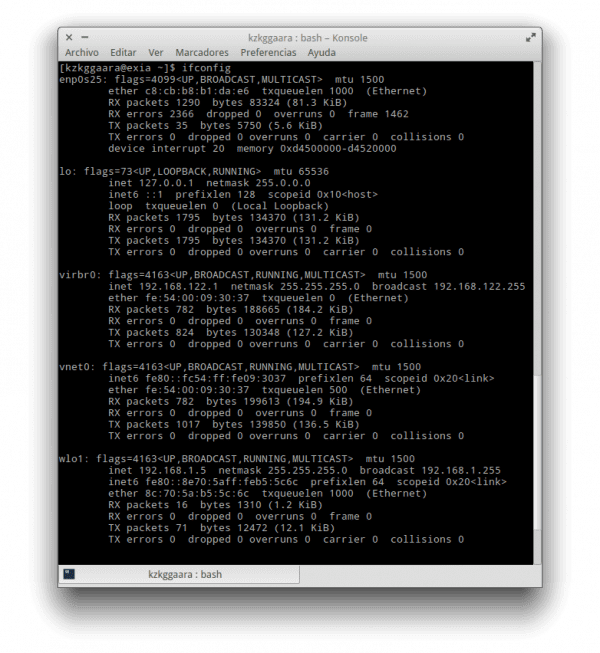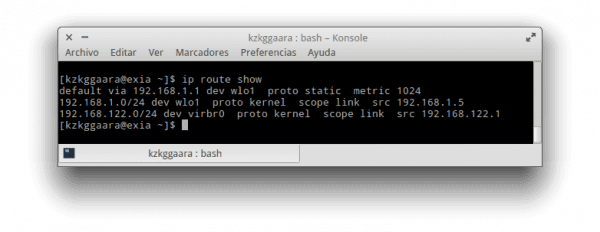Either because we are managing a server or because we do not yet have a graphical environment, there are times when we need to know all the network data that the computer to which we are connected has, here I will explain how to obtain this data.
IP adress
A simple command can tell us our IP, I mean: ifconfig
ifconfig
It will show us something like this:
As you can see, all network interfaces appear, in the 2nd line of each interface we see something like: «internet 192.168.1.5»… Inet is the IP address, for example, if I do a grep filtering inet I can show only the IPs:
sudo ifconfig | grep inet
It would show us our IPv4 and IPv6 IPs.
MAC
The same command allows us to know our MAC address, we can see it in the line that begins with "ether", we can still use a grep to filter by ether and that only our MACs appear:
sudo ifconfig | grep ether
DNS server
To know our DNS server we can see the content of the /etc/resolv.conf file:
cat /etc/resolv.conf
There we will see the domain of our network (in case we have one in the LAN) or the IP of the DNS server that we use.
Gateway or Gateway
Knowing our gateway is just as easy, we will use:
ip route show
We will see that several lines may appear, but the (generally) first line contains our gateway at the beginning, it is the line that begins with default
Anyway ... obviously you can use grep again to filter by default:
ip route show | grep default
And ... getting more exquisite we can use awk to show only the 3rd column, that of the IP:
ip route show | grep default | awk {'print $3'}
But hey, this is to get us detailed 😀
Hostname or Computer Name
Simple, very simple ... just run: hostname
hostname
The end!
So far the post goes, I do not know if I have any pending configuration ... if so, share the command to show it in a terminal 😉
Enjoy!


It never hurts to remember them
In the case of DNS, this is not always the case.
In Ubuntu or some of its derivatives the file '/etc/resolv.conf' contains 'nameserver 127.0.1.1'
How to determine the DNS configured in these cases?
This happens because the system is using: / usr / sbin / NetworkManager and it is this program that is in charge of calling / sbin / dhclient.
If you want to see all the information including the IP names of the nameserver, just run the command:
"Nm-tool"
In Ubunto and Mint it will offer you something like this:
Network Manager Tool
State: connected (global)
- Device: eth0 —————————————————————–
Type: Wired
Driver: jme
State: unavailable
Default: no
HW Address: 00: 90: F5: C0: 32: FC
capabilities:
Carrier Detect: yes
wired properties
Carrier: off
- Device: wlan0 [Auto MOVISTAR_JIJIJI] ——————————————
Type: 802.11 WiFi
Driver: rtl8192ce
State: connected
Default: yes
HW Address: E0: B9: A5: B3: 08: CA
capabilities:
Speed: 72 Mb / s
wireless Properties
WEP Encryption: yes
WPA Encryption: yes
WPA2 Encryption:yes
Wireless Access Points (* = current AP)
* MOVISTAR_D44A: Infra, F8: 73: 92: 50: D4: 53, Freq 2452 MHz, Rate 54 Mb / s, Strength 40 WPA
IPv4 Settings:
Address: 192.168.1.37
Prefix: 24 (255.255.255.0)
Gateway: 192.168.1.1
DNS: 80.58.61.250
DNS: 80.58.61.254
DNS: 193.22.119.22
DNS: 208.67.222.222
That is, all the information that the commands in this post (and some more) offer you separately at once. To know other options, you already know: «man nm-tool» 🙂
Apart from the orders:
"Hostname"
"Route"
#dig http://www.google.com | grep SERVER
and it will tell you the DNS used
As of Ubuntu 15.04 you must use:
nmcli device show
because nm-tool disappeared:
http://askubuntu.com/questions/617067/why-nm-tool-is-no-longer-available-in-ubuntu-15-04
Dear, I installed Huayra 2.0 and I have updated to 2.1.
At least in these versions, by default there is no "ifconfig" command, otherwise I use the "ip" command to see the status of the network cards:
ip addrsh
xd men jnbkj kjbkjbk kjbkj kj kj
How do I update a change of IP address of my mail server in the ISP DNS?